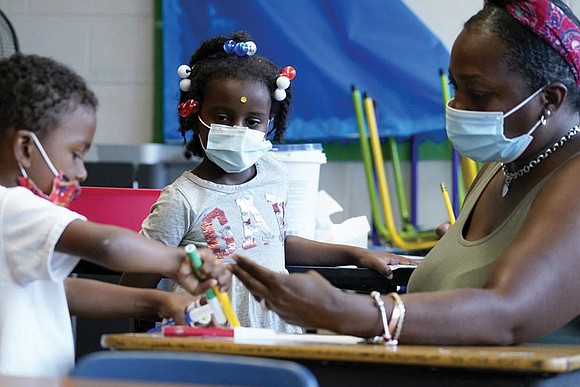Cities face crisis as fewer kids enroll and schools shrink
The Associated Press and Chalkbeat | 8/4/2022, 6 p.m.

CHICAGO On a recent morning inside Chalmers School of Excellence on Chicago’s West Side, five preschool and kindergarten stu- dents finished up drawings. Four staffers, including a teacher and a tutor, chatted with them about
colors and shapes.
The summer program offers the kind of one-on-one support parents love. But behind the scenes, Principal Romian Crockett worries the school is becoming precariously small.
Chalmers lost almost a third of its enrollment during the pandemic, shrinking to 215 students. In Chicago, COVID-19 worsened declines that preceded the virus: Predominantly Black neighborhoods like Chalmers’ North Lawndale, long plagued by disinvestment, have seen an exodus of families over the past decade.
The number of small schools like Chalmers is growing in many American cities as public school enrollment declines. More than one in five New York elementary schools had fewer than 300 students last school year. In Los Angeles, that figure was over one in four. In Chicago it has grown to nearly one in three, and in Boston it’s approaching one in two, according to a Chalkbeat/ AP analysis.
Most of these schools were not originally designed to be small, and educators worry coming years will bring tighter budgets even as schools are recovering from the pandemic’s disruption.
“When you lose kids, you lose resources,” said Mr. Crockett, the Chalmers principal. “That impacts your ability to serve kids with very high needs.”
Astate law prohibits Chicago from closing or consolidating schools until 2025. And across the U.S., COVID-19 relief money is helping subsidize shrinking schools. But when the money runs out in a few years, officials will face a difficult choice: Keep the schools open despite the financial strain, or close them, upsetting communities looking for stability for their children.
“My worry is that we will shut down when we have all worked so hard,” said Yvonne Wooden, who serves on Chalmers’ school council. Her children went to the pre-K through eighth-grade school, and two grandchildren attend now. “That would really hurt our neighborhood.”
The pandemic accelerated enrollment declines in many districts as families switched to homeschooling, charter schools and other options. Students moved away or vanished from school rolls for unknown reasons.
Many districts like Chicago give schools money for each student. That means small schools sometimes struggle to pay for fixed costs — the principal, a counselor and building upkeep.
To address that, many allocate extra money to small schools, diverting dollars from larger schools. In Chicago, the district spends an average of $19,000 annually per student at small high schools, while students at larger ones get $10,000, according to the Chalkbeat/AP analysis.
“I love small schools, but small schools are very expensive,” Chicago schools chief Pedro Martinez told the school board recently. “We can get some really creative, innovative models, but we need the funding.”
At the same time, these schools are often stretched thin. Very small schools offer fewer clubs, sports and arts programs. Some elementary schools group students from different grades in the same classroom, although Mr. Martinez has vowed that won’t happen next year.
Manley Career Academy High School on Chicago’s West Side illustrates the paradox. It now serves 65 students, and the cost per student has shot up to $40,000, even though schools like Manley offer few elective courses, sports and extracurricular activities.
“We’re spending $40,000 per pupil just to offer the bare minimum,” said Hal Woods of the advocacy group Kids First Chicago, which has studied declining enrollment in the district. “It’s not really a $40,000-per-pupil student experience.”
Small schools are popular with families, teachers and community members because of their tight-knit, supportive feel. Some argue districts should pour more dollars into these schools, many in predominantly Black and Latino neighborhoods hard hit by the pandemic. Schools serve as community hubs and points of local pride even as they lose students — as is the case in North Lawndale.
Race also looms large. Nationally, schools with more students of color are more likely to be closed, and those in affected communities often feel unfairly targeted.
The prospect of closing schools is particularly fraught in Chicago, where 50 schools were shuttered in 2013, most in predominantly Black neighborhoods. The move frayed trust between residents and the district and, according to University of Chicago research, markedly disrupted learning for low-income students.
Chicago will use about $140 million of the $2.8 billion in COVID-19 relief it got to help prop up small schools this school year, officials said. Mr. Martinez, who took over as schools chief last fall, has sidestepped talk of closures, saying he wants to study how the district can make its campuses more attractive to families — and push for more money from the state.
In contrast, Richmond Public Schools, in Richmond, Va., is working on plans now to build a new George Wythe High School in South Side. This follows the opening of three new schools—Marsh Elementary, Cardinal Elementary and River City Middle—during the pandemic.







